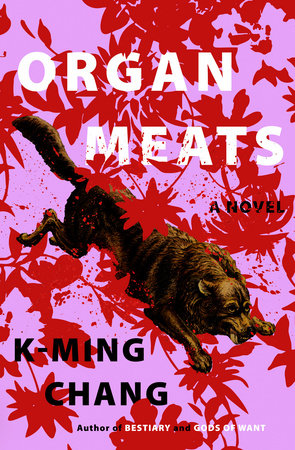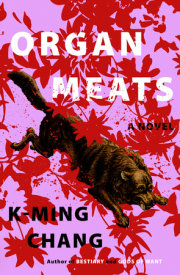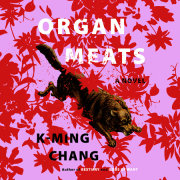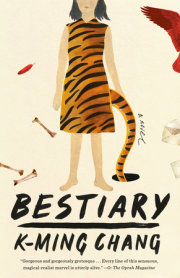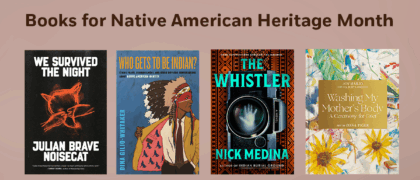Disparate Girls Discover that Doghood Is Not the Opposite of Godhood, and Anita Hsia Recounts the Ox-Boned Origin of Her Family ResidenceIn the center of summer, soft with rot, Rainie and I decide to be dogs. Cousin Vivian says you can’t be a dogpack with only two dogs, Rainie and me, but I say she forgot to count our shadows, Rainie and me plus two shadows, which makes four dogs, which is a lot of dogs. The dogs we know are strays, and they always travel in pairs or in sixes, and they sometimes get hit by cars and crows pluck the meat from their bones, though mostly they leave the bodies of the dogs alone, because there isn’t much meat on them. I decide that being a dog requires three main things: First, that we drink with our tongues, which is easy, because I drink out of bowls anyway, ever since Abu decided to grow flowers in all our glasses. The second thing is that we must have collars, because we are not strays. We belong to each other. We cannot be strays, because our ribs are not visible, mostly because we wear shirts. And we have names, mostly because we have mothers. Also, strays stink and have fleas, and we are required to bathe, though one time Rainie got bedbugs and she and her brothers wore rashes as long as capes down their backs and then Vivian and I got them too and Abu burned our sheets, bleached the carpeting. I halo Rainie’s neck with red thread from Abu’s sewing kit and make a knot where she swallows, then tie a symmetrical thread around my neck.
Now we’re collared together, I say. I get the knot right only on the second try: The first time, Rainie’s neck turns to steam, and I can’t get the thread to grip anything. There is something in her that resists it, that doesn’t want to bind herself to me. She lives by flitting. Even when she stands on the wrinkled pavement in front of me, she shifts from foot to foot like she’s surfing something, turning the street into a sea she’ll ride away from me. Rainie tugs at the thread, tries to wedge a thumb between the knot and her skin, but I tell her it has to fit us snug as a bloodline or else we can’t be synonyms.
The third thing is that we must learn to bite, even though our teeth are crooked and easily uprooted. We practice biting our own arms first, leaving purple perforated circles, and then we move on to biting shoulders, which requires our jaws to unhinge wider. I bit my cousin Vivian while she slept, kneeling in front of her mattress and gouging my teeth into her shoulder and gnawing the sphere of meat, imagining that Rainie had called me to fetch it, to bring it back to her whole, a tennis ball of bone, except we do not answer to names. When I bit her, Vivian flopped like a fish and landed outside her dreams, gasping, and I had to return her blood in a bottle. Rainie and I practice stretching our jaws, widening them enough for a crow to fly in and roost, and when our mothers see us sitting on the sofa, gaping at nothing, drool draping our chins, they leap at us and ask if we’ve become melon-headed.
When Rainie and I feel that we have properly committed to our new species, we walk the streets as a dogpack, our shadows tailing us. When our knees are sore and bleeding and gravel-crusted from crawling, we decide that we will be two-legged dogs. We sit in the shade of a bald sycamore tree, its trunk like a drunk woman hooked over the fence of an abandoned lot, and in the corner of the lot are dogs sleeping in knots, panting loud in the heat, tongues chugging like conveyor belts. We bark at them, whine, but they don’t recognize us, probably because we wear collars made of red thread, which mean we own our blood and they do not. When we lean on the fence, they leap up and foam white at the mouth, frolicking in their own snow. But they never come close enough for us to know. Rainie thinks the empty lot is full of dumped Styrofoam and exploding sofa stuffing and chunks of the moon’s infected flesh, but I know all that whiteness is the cream of their dreams. I want to enter their shoreless sleep, to paddle alongside their tongues, but Rainie and I haven’t yet convinced them that we are dogs too, and so they only watch us through the fence with eyes dark as doorways, their minds shining through like lamplight.
On the way home, we see two dogs on the street, one on top of the other, the one on top driving itself into the one on the bottom, and both of us stop, both of us watch. The dog on the bottom keeps trying to run away, its teeth barging out of its mouth. We have never seen anything move that way, the dog clambering on top, the hilt of its hips. It’s Rainie who tugs me away and says, Let’s go home, quick, let’s go, as if the dogs have caught us, as if we are the ones being watched.
The next day, when I knock on the door of Rainie’s unit, she answers with her red-thread collar on, her neck owned and boneless. Let’s be dogs, I say. Let’s go back to the sycamore that leans over the lot and let’s chew the leaves till our tongues dew with blood. But Rainie says no. I know she’s still thinking about what we saw, the dogs, the blond one, its balls swinging like apples, the sweet stink of them both. She looks behind her, as if hoping her mother might say, Stay, clean the sink with me, tweeze the overgrown carpet, but both our mothers are out at the factory, designing colors and collars to stitch onto babies. So she trots out with me, walks with me to the lot two blocks away.
On the way to the lot, the sidewalk bucks beneath our feet, meeting our steps midair, high-fiving our heels. I say the sidewalk is a skin, and trees are born out of it, roots pecking for air. But Rainie says no, it’s the heat that causes the concrete to grasp at the cool of our bodies. We don’t agree. One time, Rainie claims, she was riding a bus with her mother and she looked out the window and saw a big truck with a wasp’s ass churning the bodies of gray slugs and pouring the jelly onto the street. That’s what the sidewalk is made of, she says, while tripping on a crack as wide as a casket. Ahead, past the rows of duplexes and fourplexes jostling one another, the sycamore hooks a skeletal finger at us, beckons our breath, reels it out of our lungs. It’s so hot that the street has dissolved into tea and tries to shore at our feet, so we leap. That’s a lie, I say. It’s skin, not street. It winces if you lick it, though we can’t lick it now or our tongues will be grilled well done. And it’s called a sidewalk, I say, because you’re supposed to scuttle sideways across it like a crab. It’s not designed for our species. I hook my arm through Rainie’s and turn us sideways and shuffle us all the way to the lot, our ankles clanking like bells, our hipbones magnetizing in the heat.
Rainie says, Stop it, quit ringing me, and when we reach the fence, she unlinks from me and shoves me away. She says it’s not fair that I always get to invent the rules of doghood and she has to sniff after me. Fine, I say, you get to add a rule, but it has to be about wearing ourselves bare. We will be skin-only, and no one at school will make fun of us for wearing matching horizontally striped shirts our mothers sewed for us that make us look like Ronald McDonald and are too tight at the armpits and rip when we raise our hands. We will achieve the freedom of another being. I summon up a fist of spit, frothing at the mouth.
Foaming is not the freedom of another being, Rainie says. That’s rabies. She steps away from the fence and toward the shadow of the sycamore. If we have rabies, she says, who’s going to give us dinner? Rainie only believes what she can eat. Her mother says she has to be fed every day at the same time or else she will swallow her shadow and skin herself. Already, Rainie is scraping bark from the sycamore tree. While her mouth is dissolving the sycamore’s scalp, I squat among the roots and tickle the sidewalk with a stick. It shivers and nips off the tip. Fine, I say, then what’s your rule? Being part of this dogpack is a lot of work, and you have to do your share. There is one dog tightening the screws of its teeth in the far end of the lot, its head the color of crusted blood, and its job is to pee on the sycamore and fertilize the lot in all four corners. At least it’s trying to contribute.
I’m trying to contribute, Rainie says, spitting out bark. But you keep interrupting. She squats with me between two roots and says she’s thinking. For Rainie, thinking and eating are synced activities, and her molars are gritting like the gears of her mind. When she’s finished sipping up a ribbon of bark as long as our arms, she stands and gestures at the rusted fence, says she’s decided. The red thread around her neck is glowing, and I know she’s going to test me. Try, I say. Whatever you’ve invented is already inside me.
My rule, Rainie says, her head turned toward the fence, is that you have to poop in the lot like they do.
I swallow all the foam in my maw and walk up to the fence. In the holes of it, dogs are curled in sleep. Some of them are missing ears, and someone has been sewing for them: The blood-colored dog is closest to the fence, and its right ear is a sycamore leaf stitched to its skull with red thread. The other is a lobe of Spam. Ten feet from me, the dog is humming static in its sleep like a radio. If I climb the hot fence and crawl into the lot, the red one will wake, so instead I eye the diamond-shaped peepholes and identify the one that aligns with my intentions.
Copyright © 2023 by K-Ming Chang. All rights reserved. No part of this excerpt may be reproduced or reprinted without permission in writing from the publisher.

